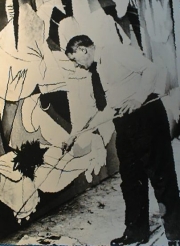 Picasso painting Guernica
Picasso painting Guernica "GUERNICA - ART AGAINST WAR"
Guernica, 1937, 350 cm x 750 cm, oil on canvas, Reina Sofia Art Center, Madrid
 Picasso painting Guernica
Picasso painting Guernica
In January 1937, Pablo Picasso was made responsible(some information on Spanish history) for painting a wall picture for the Spanish pavilion on the Paris World Fair by the Spanish-republican government. It should make people aware of the situation in Spain during those days - civil war. His painting was placed on a wall just next to the entrance as this wall was prominent and the only place on the ground floor which was protected from weather. (He was offered $ 7.500 for this piece of work.)
In April of the same year his friend José Bergamín had (in an article in the arts magazine "Cahiers d'Art") demanded a work of art which was to call to arms and protest against the rebelling Spanish fascists led by Franco, who were becoming more and more successful in respect to military actions. Picasso saw himself confronted with clearly formulated expectations. His answer was a completely non-political theme, "Bathers" and "Painter and model". Hereby is shown that he in the beginning did not identify with Bergamín's demands concerning party discipline.
However, on 26th April, 1937, the Spanish town of Guernica was air-raided by the nazi-German "Legion Condor", which was fighting together with Franco. The town was not of any strategic meaning at all, with no republican troops being stationed there. The bombardment was an attack on civilians and a symbol of destroying the centre of Basque history and identification. (In Guernica there stood the so-called "Holy Oak", at which the Spanish kings once used to swear to the fundamental rights of the Basques.) The attack cost 1654 lives and wounded 889 persons - it mostly affected old people, women and children. The brutality of this action grieved Picasso very much; so he changed his plans towards making Guernica the topic for his painting.
The painting depicts a space filled with dead and mutilated people, a horse in the centre and a bull on the left. To the left of the centre there is a lamp hanging from the upper edge of the painting which sends short and sharp rays of light to the lying and fleeing. The limbs are cut off people and animals, they are thrown to the ground. The hand lying in the foreground holds a flower and a broken sword. From the right another hand holds out an oil lamp to the electric lamp. In the middle a cone of light can be seen whose outlines cut the bodies optically. The dominating colours are black, grey and white.
The raid itself is not shown in "Guernica". Picasso does not paint any bombers, any perpetrators; instead of them he paints their victims. The depicted space is filled with dead, injured, dismembered and torn bodies. The points of intersection of seemingly uncoordinated lines, which are spread all over the painting, become centres of explosions, they blow up the whole of the picture. While the World Fair praised the new electricity as a modern "way of overcoming night", the lights in Guernica went out in broad daylight. The proportions of light in "Guernica" are a witness of this violence. The lamp on the ceiling is made into an exploding incendiary.
Light becomes an instrument of violence (The same idea in Adorno's "Dialektik der Aufklaerung".): the cone of light right of the centre, which is presented in an abstract way and comes in like a spotlight, is not meant to light up the stage - it (on the contrary) "tears off" the horse's legs. The cone also splits up the woman lying on the ground, who can just hold up her hand in accusation of this violence. The powerlessness over the atrocity is mostly expressed in the hand which is holding a flower and a broken weapon.
Nevertheless, many things remain a puzzle, the meaning of the mighty bull for example. It can be understood as a symbol for the attackers' brutality as well as for the endangered Spain. Even the collective learning of art historians has not been able to solve this question. One can obviously not interpret the painting (like an old myth) with the help of a sign language which can be read like different icons. This corresponds to Picasso not fulfilling the expectation of a painted call to arms. That does not mean the picture was not immediately seen as a great confession of Picasso's, as an accusation and as an outcry.
(Picasso made the end of Franco's dictatorship a condition for exhibiting the picture in Spain. It was not brought to the Madrid museum before 1981 - after Franco's death and the change to democracy.) It is a signal and programme against war and fascism.
Sources: